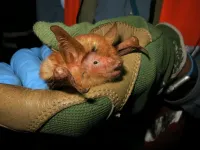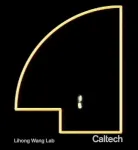(Press-News.org) Skoltech researchers have found a way to use chemical sensors and computer vision to determine when grilled chicken is cooked just right. These tools can help restaurants monitor and automate cooking processes in their kitchens, and perhaps one day even end up in your 'smart' oven. The paper detailing this research results, supported by a Russian Science Foundation grant, was published in the journal Food Chemistry.
How do you tell that chicken breast on your grill is ready for your plate? You probably look at it closely and smell it to make sure it is done the way you like it. However, if you are a restaurant chef or head cook at a huge industrial kitchen, you cannot really rely on your eyes and nose to ensure uniform results up to the standards your customers expect. That is why the hospitality industry is actively looking for cheap, reliable, and sensitive tools to replace subjective human judgment with automated quality control.
Professor Albert Nasibulin of Skoltech and Aalto University, Skoltech senior research scientist Fedor Fedorov and their colleagues decided to do just that: get an 'e-nose,' an array of sensors detecting certain components of an odor, to 'sniff' the cooking chicken and a computer vision algorithm to 'look' at it. 'E-noses' are simpler and less expensive to operate than, say, a gas chromatograph or a mass spectrometer, and they have even been shown to be able to detect various types of cheeses or pick out rotten apples or bananas. On the other hand, computer vision can recognize visual patterns - for instance, to detect cracked cookies.
The Skoltech Laboratory of Nanomaterials, led by Professor Nasibulin, has been developing new materials for chemical sensors; one of the applications for these sensors is in the HoReCa segment, as they can be used to control the quality of air filtration in restaurant ventilation. A student of the lab and co-author of the paper, Ainul Yaqin, traveled to Novosibirsk for his Industrial Immersion project. He used the lab sensors to test the effectiveness of industrial filters produced by a major Russian company. That project led to experiments with the smell profile of grilled chicken.
"At the same time, to determine the proper doneness state, one cannot rely on 'e-nose' only but have to use computer vision -- these tools give you a so-called 'electronic panel' (a panel of electronic 'experts'). Building on the great experience in computer vision techniques of our colleagues from Skoltech CDISE, together, we tested the hypothesis that, when combined, computer vision and electronic nose provide more precise control over the cooking," Nasibulin says.
The team chose to combine these two techniques to monitor the doneness of food accurately and in a contactless manner. They picked chicken meat, which is popular across the world, and grilled quite a lot of chicken breast (bought at a local Moscow supermarket) to 'train' their instruments to evaluate and predict how well it was cooked.
The researchers built their own 'e-nose,' with eight sensors detecting smoke, alcohol, CO, and other compounds and temperature and humidity, and put it into the ventilation system. They also took photos of the grilled chicken and fed the information to an algorithm that specifically looks for data patterns. To define changes in odor consistent with the various stages of a grilling process, scientists used thermogravimetric analysis (to monitor the number of volatile particles for the 'e-nose' to detect), differential mobility analysis to measure the size of aerosol particles, and mass spectrometry.
But perhaps the most important part of the experiment involved 16 PhD students and researchers who taste-tested a lot of grilled chicken breast to rate its tenderness, juiciness, intensity of flavor, appearance, and overall doneness on a 10-point scale. This data was matched to the analytical results to test the latter against humans' perception who usually end up eating the chicken.
The researchers grilled meat just outside the lab and used the Skoltech canteen to set up the testing site. "Due to the COVID-19 pandemic, we had to wear masks and perform testing in small groups, so it was a rather unusual experience. All participants were given instructions and provided with sensory evaluation protocols to do the job properly. We cooked many samples, coded them, and used them in blind tests. It was an exciting experience for material scientists mainly and relied on data from sophisticated analytical tools. But, chicken tissues are materials too," Fedorov notes.
The team reports that their system was able to identify undercooked, well-cooked, and overcooked chicken quite well, so it can potentially automate quality control in a kitchen setting. The authors note that to use their technique on other parts of the chicken - say, legs or wings - or for a different cooking method, the electronic 'nose' and 'eyes' would have to be retrained on new data.
The researchers now plan to test their sensors in restaurant kitchen environments. One other potential application could be 'sniffing out' rotten meat at the very early stages when changes in its smell profile would still be too subtle for a human nose.
"We believe these systems can be integrated into industrial kitchens and even in usual kitchens as a tool that can help and advise about the doneness degree of your meat, when direct temperature measurement is not possible or not effective," Fedor Fedorov says.
INFORMATION:
Skoltech is a private international university located in Russia. Established in 2011 in collaboration with the Massachusetts Institute of Technology (MIT), Skoltech is cultivating a new generation of leaders in the fields of science, technology, and business is researching in breakthrough fields, and is promoting technological innovation intending to solve critical problems that face Russia and the world. Skoltech is focusing on six priority areas: data science and artificial intelligence, life sciences, advanced materials and modern design methods, energy efficiency, photonics, and quantum technologies, and advanced research. Web: https://www.skoltech.ru/.
Scientists tame photon-magnon interaction.
Working with theorists in the University of Chicago's Pritzker School of Molecular Engineering, researchers in the U.S. Department of Energy's (DOE) Argonne National Laboratory have achieved a scientific control that is a first of its kind. They demonstrated a novel approach that allows real-time control of the interactions between microwave photons and magnons, potentially leading to advances in electronic devices and quantum signal processing.
Microwave photons are elementary particles forming the electromagnetic waves that we use for wireless communications. On the other hand, magnons are the elementary particles forming what scientists call "spin waves" -- wave-like disturbances in ...
In a study in mice and human cells, Johns Hopkins Medicine researchers say that they have developed a tiny, yet effective method for preventing premature birth. The vaginally-delivered treatment contains nanosized (billionth of a meter) particles of drugs that easily penetrate the vaginal wall to reach the uterine muscles and prevent them from contracting. If proven effective in humans, the treatment could be one of the only clinical options available to prevent preterm labor. The FDA has recommended removing Makena (17-hydroxyprogesterone caproate), the only approved medicine for this purpose, from the market.
The study was published Jan. 13 in Science Translational Medicine.
There ...
A group of scientists led by the American Museum of Natural History and Bat Conservation International have discovered a new species of a striking orange and black bat in a mountain range in West Africa. The species, which the researchers expect is likely critically endangered, underscores the importance of sub-Saharan "sky islands" to bat diversity. The species is described today in the journal American Museum Novitates.
"In an age of extinction, a discovery like this offers a glimmer of hope," said Winifred Frick, chief scientist at Bat Conservation International and ...
With the impact of climate change increasing by the day, scientists are studying the ways in which human behavior contributes to the damage. A recent study at Walla Walla University, by a collaboration of researchers from Walla Walla University and La Sierra University, examined the effects of acidic water on octopuses, potentially bringing new insight into both how our activities impact the world around us, and the way that world is adapting in response.
The study, "Impact of Short- and Long-Term Exposure to Elevated Seawater PCO2 on Metabolic Rate ...
The human organism requires a variety of small molecules, such as sugars or fats, in order to function properly. The composition of these so-called metabolites and their interaction - the metabolism - varies from person to person and is dependent not only on external influences, such as nutrition, but also to a significant extent on natural variations in our genetic make-up. In an international study, scientists from the Berlin Institute of Health (BIH) and Charité - Universitätsmedizin Berlin joined forces with colleagues from the United Kingdom, Australia and the United States and discovered hundreds ...
A new study from UBC researchers suggests a strong correlation between following the MIND and Mediterranean diets and later onset of Parkinson's disease (PD). While researchers have long known of neuroprotective effects of the MIND diet for diseases like Alzheimer's and dementia, this study is the first to suggest a link between this diet and brain health for Parkinson's disease (PD).
The MIND diet combines aspects of two very popular diets, the Mediterranean diet and the Dietary Approaches to Stop Hypertension (DASH) diet.
"The study shows individuals with Parkinson's disease have a significantly later age of onset if their eating pattern closely aligns with the Mediterranean-type diet. The difference shown in the study was up to 17 years later in women and eight years later ...
There are things in life that can be predicted reasonably well. The tides rise and fall. The moon waxes and wanes. A billiard ball bounces around a table according to orderly geometry.
And then there are things that defy easy prediction: The hurricane that changes direction without warning. The splashing of water in a fountain. The graceful disorder of branches growing from a tree.
These phenomena and others like them can be described as chaotic systems, and are notable for exhibiting behavior that is predictable at first, but grows increasingly random with time.
Because of the large role that chaotic systems play in the world around us, scientists and mathematicians have long sought to better understand them. Now, Caltech's Lihong Wang, the Bren Professor in the Andrew and ...
CORVALLIS, Ore. -- A recent study from Oregon State University found that after Oregon expanded Medicaid in 2014, more women were able to receive insurance coverage for abortion services, rather than paying out of pocket.
In analyzing Medicaid claims data and other medical records, researchers found that the Medicaid-financed share of total abortions increased each of the first three years following the state's Medicaid expansion. The incidence of Medicaid-financed abortions increased 18% in 2014, then 7% each in 2015 and 2016.
The total number of abortions in the state did not rise; rather, the expansion shifted who paid for them.
"According to the literature, there was a 1% decline in the abortion rate in Oregon between 2014 and 2017. During the pre-expansion ...
As marijuana outlets open after the drug is legalized, the density of those recreational retailers is associated with more use and a greater intensity of use among young adults, according to a new RAND Corporation study.
The study is among the first to examine associations between the density of marijuana outlets and marijuana use over time, and is the first to include unlicensed dispensaries in such an analysis.
Studying young adults in Los Angeles County the year before and the year after marijuana was available for recreational purchase in ...
TROY, N.Y. -- Blood sample analysis showed that, two to five years after they gave birth, mothers of children with autism spectrum disorder (ASD) had several significantly different metabolite levels compared to mothers of typically developing children. That's according to new research recently published in BMC Pediatrics by a multidisciplinary team from Rensselaer Polytechnic Institute, Arizona State University, and the Mayo Clinic.
Researchers analyzed blood samples from 30 mothers whose young children had been diagnosed with ASD and 29 mothers of typically developing children. At the time that the samples were taken, the women's children were between 2 and 5 years old. The team found differences in several metabolite levels between the two groups of mothers. ...



